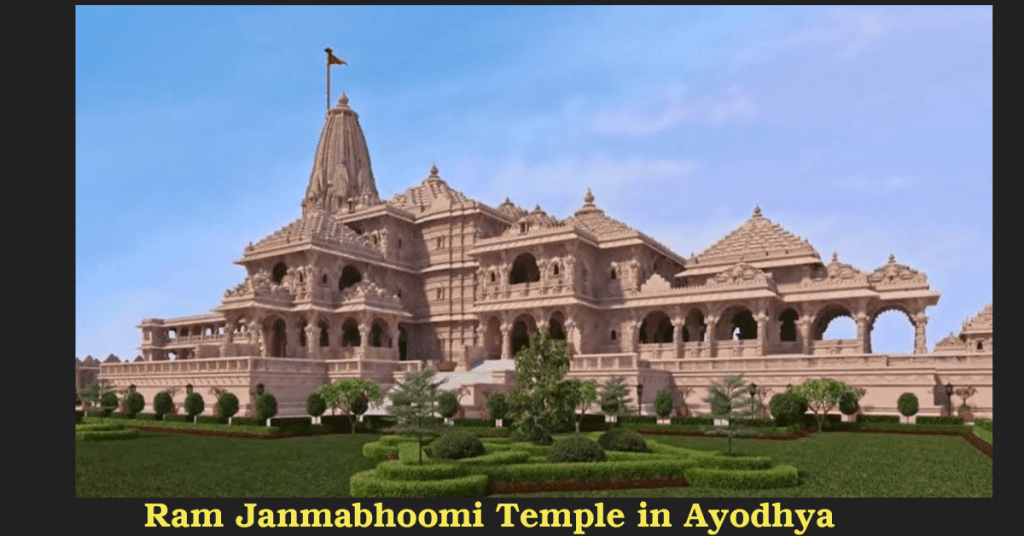Temples, Temples In Uttar Pradesh
Ram Janmabhoomi Temple in Ayodhya : History,Location,significance
Introduction
For many years, the Ram Mandir temple in Ayodhya has been a religious and political debating point in India. A place closely associated with Lord Rama, the seventh incarnation of Lord Vishnu, Ayodhya remains a sacred place for the Hindus. It is regarded as one of the seven sacred cities of the Hindus because of its association with the great Indian epic Ramayana
Let us embark on the historical journey of Ram Mandir Temple in Ayodhya.
Ram Mandir History
Ayodhya, a holy place revered by the Hindus, situated on the bank of the river Saryu, is where Lord Rama was born to King Dasaratha. According to historical accounts, a massive Ram temple was once built in Ayodhya before being demolished by medieval Muslim invaders and replaced by the Babri Masjid. In 1528, the Mughal general Mir Baqi built the Babri Masjid in what was historically recognized as Rama’s native land.
And since then, the site has frequently been controversial because of its symbolic importance to both Hindus and Muslims. The upheaval had its beginning stages in the 1850s. By the 1980s, the Vishwa Hindu Parishad had initiated a new course of action to reconquer Ayodhya for Hindus and construct a temple obligated solely to Lord Rama. Riots erupted in northern India in 1990 due to the claims of both groups over this religious site.
The year-long conflict reached a climax on December 6, 1992, when the masjid was destroyed by members of another group in just a few hours. Without a doubt, the demolition of the three-story mosque had disastrous consequences. Several intercommunal riots erupted across the country, killing approximately 2000 people. This was not the end of it, as neighboring Pakistan and Bangladesh witnessed the destruction of Hindu temples & uprisings.
A significant victory for the Ram Bhakts.
An archaeological excavation conducted by the Archaeological Survey of India (ASI) deciphered the remains of Hindu temples. By 2019, the Supreme Court of India had decided to issue a landmark decision that the Hindus had anticipated for many years. As a result, the Indian government transferred the unsettled land to a trust named Shri Ram Janmabhoomi Teerth Kshetra for the purpose of constructing the Ram Mandir. The Narendra Modi government officially confirmed in Parliament on February 5, 2020, that it had approved the proposal to build the temple. Moreover, a 5-acres of land was handed over to Sunni Waqf Board for the construction of a new mosque.
The Construction
The much-awaited construction of Ram Janmaboomi temple in Ayodhya finally came true in 2020. By March 2020, the Shri Ram Janamabhoomi Teerth Kshetra initiated the first phase of building the temple. However, due to the outbreak of the Covid-19 pandemic, the construction couldn’t work as planned. A Shivaling, pillars, and broken figurines were also discovered at the time of ground-leveling and unearthing at the building area.
On August 5, 2020, the temple’s ceremonial construction took place, followed by Bhoomi Poojan. Prime Minister Narendra Modi graced the occasion by laying a 40 kg silver brick featuring it as the foundation stone. Undoubtedly, it will be etched in the history of India for its grand ceremony, which lasted with three-day Vedic rituals.
Design & Framework of the Ram Mandir
Larsen and Toubro are building the temple, with Tata Consulting Engineers serving as the project’s management consultant. With a 3D animated video, the trust announced the ‘divine project’ on Twitter. The splendid Ram Temple is seen densely forested by lush greeneries. Furthermore, the temple’s pillars and walls also featured illustrations of Gods and Goddesses.
Ayodhya Ram Mandir’s current status
According to the report, the groundwork has been set, and the plinth or pedestal raising work, launched on January 24 2022, is currently underway. And the sanctum sanctorum of the temple, which will house the Ram Lalla idol, will be available for darshan by December 2023. At the same time, the overall temple’s construction will proceed and will be accomplished by 2025.
Ram Mandir, Ayodhya Location
Ram Mandir is a Hindu temple in Ayodhya, Uttar Pradesh, India, devoted solely to the deity Ram. The temple is one of the four major Hindu pilgrimage sites known as the Char Dham. It is considered to be Ram’s birthplace and is a highly sacred site for Hindus. The Muslim community claims ownership of the temple, which has been the subject of a long-running legal dispute.
Donations
Various provisions are available for donation, such as cheques, bank transfers, and UPI id transactions. Anyone can donate through the UPI id shriramjanmbhoomi@sbi. Moreover, there are options for NEFT, IMPS, RTGS or quickpay.
Conclusion
It is indeed a matter of great pride and joy that Ayodhya, the city associated with Lord Rama, is now sheltered by the Ram Janmabhoomi Temple. The devotees’ long-awaited dream came true after a period of turmoil, and we will soon see the serene and divine land we have heard about for centuries.
Read More: https://pujanpujari.com/kedarnath-temple-historymythologytemple-rituals-pooja-timings/


It’s a nice article that covers major aspects of Lord Ram’s place of birth.
Thank You stay Tune for new articles
Nice…